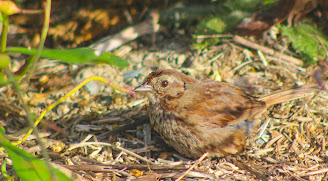Humboldt Bay National Wildlife Refuge is located on the coast of California near Eureka and Arcata. It was established in 1971 and exists primarily to help migratory waterbirds on the Pacific Flyway. It has several different units and consists of just under 4,000 acres. It includes mudflats, eelgrass meadows, saltmarsh, brackish marsh, seasonally flooded freshwater wetlands, riparian wetlands, streams, coastal dunes and forest.
I visited the South Humboldt Bay Salmon Creek Unit on August 10, 2020 with Sam, which is south of Eureka, and did the 2.1 mile Shorebird Loop Trail which starts at the Visitors Center. Most of the migratory birds come through from November to March, so I was there at a slow time and seeing resident birds and animals.
I've just signed up on iNaturalist which has increased my interest in plants. So I took a number of photos of them.
 |
Bird's-foot trefoil
|
 |
Bull thistle
|
 |
Cattails
|
 |
Common cat's-ear
|
 |
White clover
|
 |
Wild carrot - the early flower.
|
 |
This close-up of the wild carrot shows that the flower is really an amalgam of many small flowers that start out as white and then start to turn pink.
|
 |
This is a later version, showing the flowers that have turned pink.
|
 |
Eventually the flowers turn purple and begin to curl up.
|
 |
A look inside the wild carrot - up-turned flower.
|
 |
Wild radish
|
 |
Jointed charlock - the full plant is below.
|
I was there expecting to see birds and was a little disappointed there were not more.
 |
I saw multiple song sparrow: this and the next three photos.
|
 |
I believe this is a savannah sparrow.
|
 |
A white-crowned sparrow
|
 |
A different view of the crown on the white-crowned sparrow's head.
|
 |
An American robin.
|
 |
Multiple views of the same great blue heron.
|
 |
I saw multiple great white herons, or great egrets.
|
 |
My best views were of a snowy egret that I took quite a few pictures of. It let me get relatively close.
|
 |
The most exciting find came at the end. I saw a North American river otter in a small stream just to the east of the first long pond. I saw it in the water swimming toward a bird which flew away before it got it, although it made a splashing attempt. Then it went underwater, further away, when I next saw it and got my photos. The light is bad and the quality is poor, but I was excited to get these images on film.
|
I was happy to have made the visit. This was only the third river otter I've ever seen and the first one I've photographed: The first was in the Boundary Waters of northern Minnesota; and the second was in the Okefenokee NWR in southern Georgia. It was worth the visit just to see the otter. But more than that, it opened up my view to birds on the west coast that I've seen many of in Florida (the great egret and snowy egret).



































Egrets are my favorite. I love the way they stand out and their long, graceful necks. I am surprised to see a robin among these pictures. It seems kind of out of place.
ReplyDelete